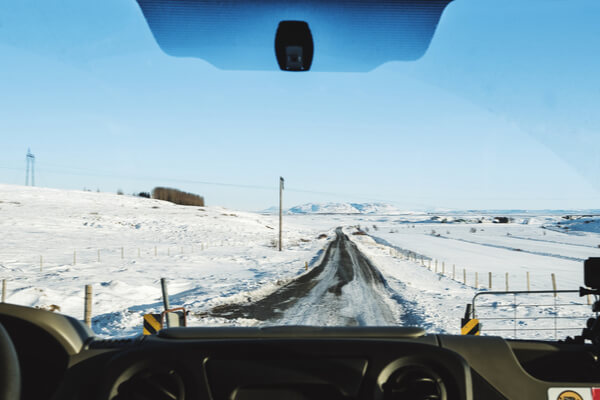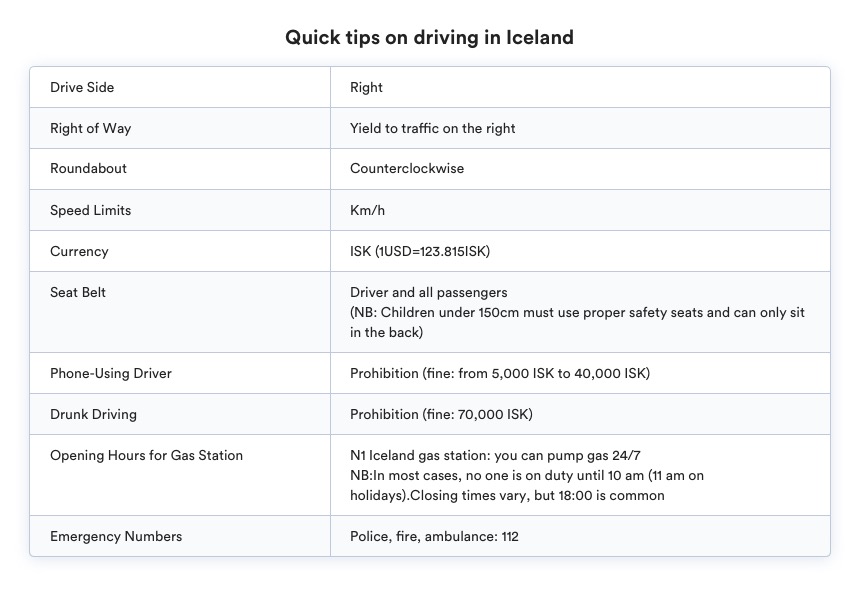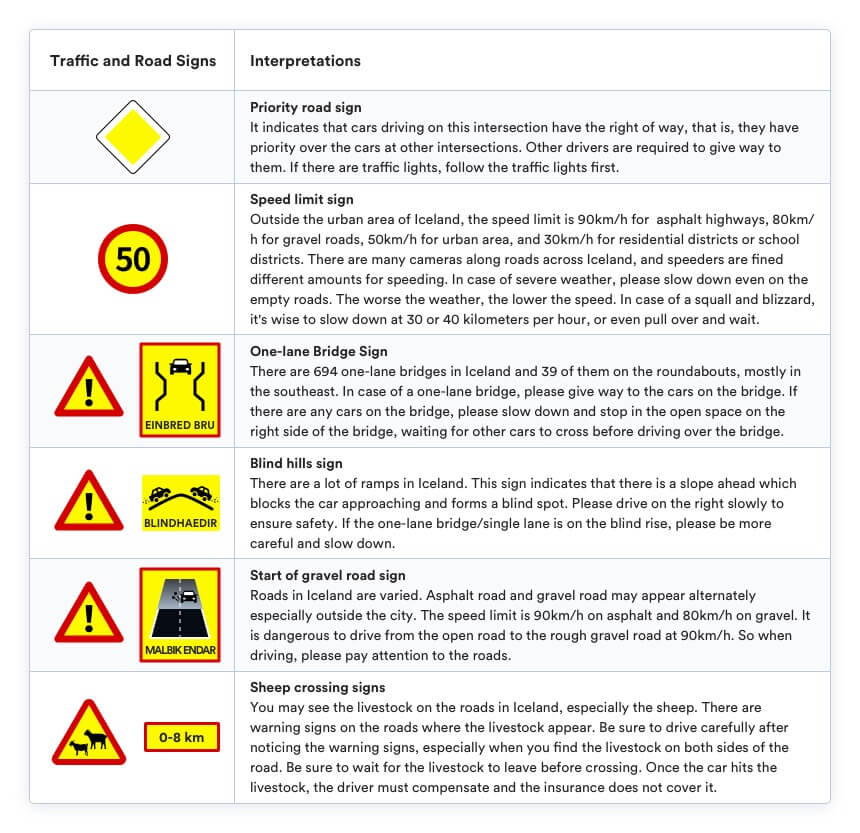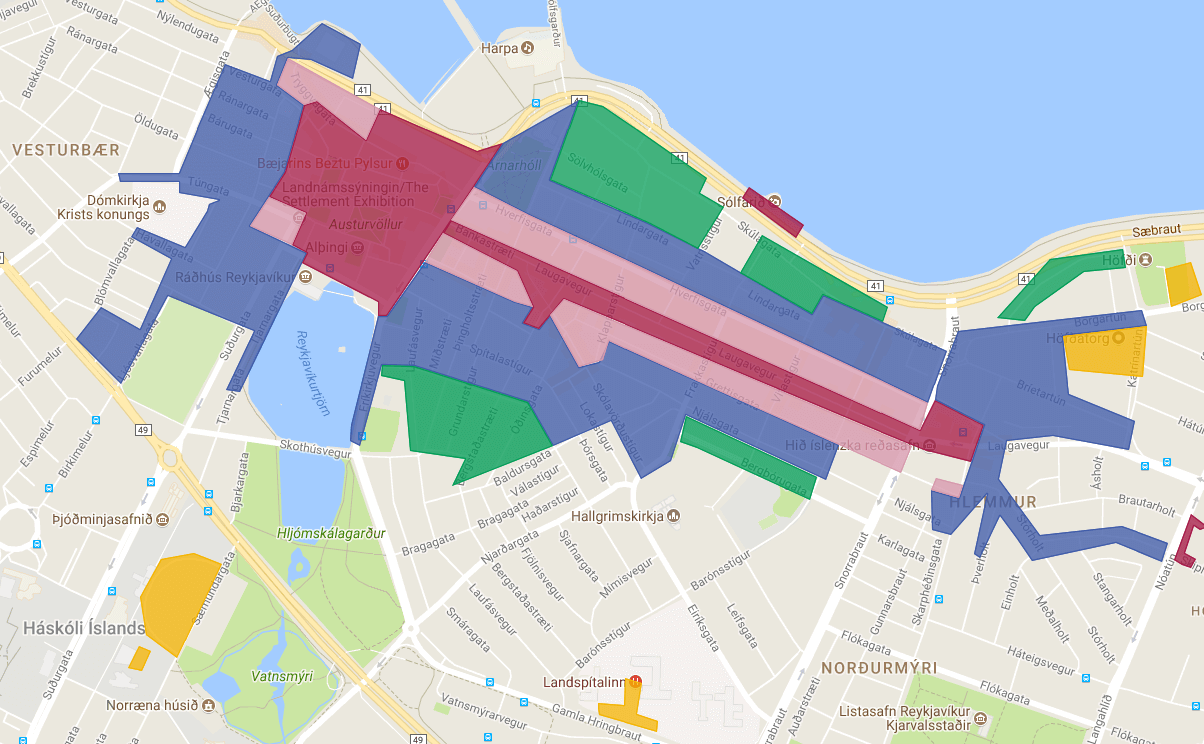The population in Iceland is sparse and unevenly distributed. The public transport is underdeveloped and no trains or subways are available. The bus service is inconvenient and inefficient and some buses even come once for a day at weekends. So, to enjoy the scenery freely and comfortably, self-driving is your best option.
1. Driving Rules and Tips
- Speed Limits
Regardless of your country of origin, speed limits are a strict traffic rule that must be observed! But did you know that Iceland and some other European countries use kilometers/hour rather than miles/hour? To help you grasp the different speed metrics, one mph roughly equates to 1.6 km/h. The following speed limits apply to different roads in Iceland:
i. Urban areas – 50 km/h (31 mph)
ii. Rural gravel roads – 80 km/h (50 mph)
iii. Paved rural roads – 90 km/h (55.9 mph)
iv. Residential areas – 30 km/h (18.6 mph)
Some major urban highways well separated from pedestrians have higher limits of 60–80 km/h.
Expert tips: Iceland also has lower advisory speed limits, those are indicated by rectangular blue signs with white letters. They are mainly used in trouble spots on rural highways such as when approaching a sharp corner or a single-lane bridge.
- Traffic and Road Signs
For more information about Iceland’s road signs, here is an infographic from QEEQ.COM.
2. Road Condition and Toll Roads
- Road Condition
Most of the roads in Iceland are covered with crushed gravel, narrow, bumpy and even higher than the ground. Therefore, when a car comes across, please slow down especially when approaching the road edge or stop to yield if necessary because heavy wind and the rough road may lead to accidents.
Many mountain and inland roads are not accessible until the end of June at the earliest because of snow and mud. Being accessible, most roads are only suitable for four-wheel cars.
Expert tips: In winter, most roads in Iceland are covered with ice and the car may skid. The unique natural landscape in Iceland may distract you from driving, making driving in winter more dangerous. Please note that Iceland’s roads are sometimes covered with thin and black ice, which can easily be mistaken for being ice-free. So, please drive slowly and carefully.
- Toll Roads
There are a few toll roads in Iceland. The only toll road in Iceland is in Hvalfjörður, which charges ISK 1,000. It takes about 7 minutes to go along the submarine tunnel or about 1 hour for a detour.
How to pay?
There are eTag channels for self-service and Cash-Card channels for staff service at the toll station. Generally, tourists do not install eTag and they can contact the staff to install eTag when picking up the car. If not, it is suggested to go towards the yellow channel for staff service where tourists can pay in cash or by card.
3. Gas
There are several chain gas stations in Iceland, most of which are the N1 gas station. When refueling in Iceland, you can follow the instructions on the car or the fuel tank cap and fill the tank with the designated fuel. If you are not sure which fuel to choose, consult the branch staff when picking up the car.
Be careful not to fill the tank with the wrong fuel. If you refuel with the wrong fuel, please contact the branch as soon as possible to clean up the fuel tank and the fuel system and conduct an overall inspection of the engine. Don’t start the car in haste to avoid car damage.
How to pay?
There is staff for refueling in Reykjavik and other big cities but at most of the gas stations, you have to refuel by yourself. For self-service refueling, you can pay in three ways, by credit card, by gas card or by credit card or cash at the store counter.
i. Refueling with credit card
Steps are as follows:
Step1: Insert the credit card and enter the PIN CODE (namely Personal Identification Number)
Step2: Enter the price of fuel
Step3: Remove the credit card
Step4: Pick up the fuel pump nozzle and start filling up
Step5: Put the nozzle back after refueling
Step6: The receipt will be printed automatically by the pump
ii. Refueling with a gas card
If the credit card cannot be used, you can buy the gas card in the supermarket for ISK 2000, 5000 or 10000. After buying the gas card, you can directly insert it into the machine to refuel.
iii. Refueling at the store counter by credit card or cash
Usually, there are convenience stores next to the gas station. You only need to tell the clerk what fuel your car takes and pay after filling up. Please note that generally, the stores in the suburbs will not open too late and sometimes there are only oiling machines and no stores, so it is necessary to refuel in advance.
More Information:
Refueling by the staff
In big cities, there is usually staff for refueling but the price is slightly higher. Just inform the staff of the oil type and amount.
Expert tips:
1. The PIN CODE is required when you use the credit card in Iceland. It is recommended to prepare a gas card in case the credit card cannot be used. If the gas card has a remaining balance, it can be used when you shop in the store.
2. Each gas station in Iceland is far away from each other. In remote areas, gas stations are rare and expensive. It is recommended to fill up the tank before setting off.
4. Parking
In Iceland, except for big cities, parking is usually free and very convenient.
In big cities like Reykjavik, parking on urban roads will usually be charged. There are four parking areas, P1-P4 in Reykjavik. The number represents the location. The parking lots next to the city center are almost all P1, and parking fees are higher. As shown in the following figure:
P1 (Red — ISK 250 per hour)
P2 (Blue — ISK 120 per hour)
P3 (Green — ISK 80 per hour for the first two hours, and ISK 20 the following hours) Charging hours: 8.00 – 16.00 Monday to Friday
P4 (Orange — ISK 120 an hour) Charging hours: Mon-Fri: 8:00-16:00
This is a general rule, but it is subject to the sign in the parking lot. The following picture shows the P2 parking lot, which charges from 09:00 to 18:00 on weekdays, and from 10:00 to 16:00 on Saturdays.
Expert tips: It is recommended to see whether there are signs or machines for payment around when parking, or whether there are parking receipts under the windshield of the surrounding cars, to determine whether it is a charging parking lot.
How to pay?
In Iceland, you should pay the parking fee by yourself. After buying the ticket at the self-service payment machine, please place the ticket under the windshield for inspection. If you park the car overtime or don’t buy the tickets, the fine is high.
Expert tips: While driving in Iceland, you may enjoy the beautiful scenery along the way. If you want to park and take photos, please park in the temporary parking area where parking is allowed. Parking on the roadside is forbidden.
5. Tickets
How to pay?
If the car rental company can pay for it, you have to pay more money than the fee because it covers the service fee.
If the car rental company cannot pay for it, you have to visit the website on the ticket and input the ticket number and then the credit card information to pay the fee as required. After receiving the ticket, please pay it within the required time and there will be a 25% discount. If not, there will be a high late fee.
If there is no violation record during the rental period, the deposit will be automatically returned to the main driver’s credit card.
Visit QEEQ.COM now.
QEEQ.COM guarantees the most competitive car rental deals for your travel and the secret is our Price Drop Protector program! We can automatically track your rental rates and RE-BOOK you if prices drop! See how our customers love this feature here.






Incredible post there. Thanks for sharing!
I every time spent my half an hour to read this webpage’s posts daily along with a mug of coffee.
Really thankful for your comment. Please keep reading our posts, you’ll find more interesting topics;)
It is not my first time to pay a visit this web site,
i am visiting this site dailly and take fastidious facts from here
everyday.